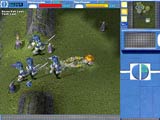 |
|
|
 The latest title from Talonsoft, Metal Fatigue, lives up to at
least one word in its name. I’m
exhausted after this game. Mortally and
morally tired. The vagaries of CorpoNation
warfare, the pitfalls of fraternal conflicts, and the truly staggering complexity of
managing armies in this game have devolved me in a drooling ape who regularly wakes up at
his keyboard after yet another marathon session with a cramped back and keyboard indents
in his forehead. This is both this game’s
promise and it’s problem. The latest title from Talonsoft, Metal Fatigue, lives up to at
least one word in its name. I’m
exhausted after this game. Mortally and
morally tired. The vagaries of CorpoNation
warfare, the pitfalls of fraternal conflicts, and the truly staggering complexity of
managing armies in this game have devolved me in a drooling ape who regularly wakes up at
his keyboard after yet another marathon session with a cramped back and keyboard indents
in his forehead. This is both this game’s
promise and it’s problem. Metal Fatigue
doesn’t make any advances in storytelling. You
play one of three brothers, each working for a different CorpoNation (Diego of Rimtech,
Stefan of Mil-Agro, and Jonus or Neuropa) and battling for control of Hedoth, the alien
system of an older and apparently extinct civilization whose technology you are in the
processes of swiping. On the up side, the
narrative is advanced through the personal journals of each brother during mission
briefings. This adds a nice, if small,
narrative touch, but you didn’t really come to across the galaxy to read novels or
become emotionally invested in the characters. You
came to kick a little ass with some fancy robots.
The rest of Metal
Fatigue, in terms of its RTS components, is uninspired.
Each CorpoNation has the same support units (tanks, artillery, missile
jeeps, useless and quick-to-die hoverjets, and a thing called the nemesis that injures
Combots) with are pretty much impotent against their hulking betters. They’re also expensive. Watching a single Combot with a hammer make short
work of your tank battalion is depressing. With
so much work going into the big boys, it’s too bad that more time couldn’t have
been spent individualizing each CorpoNation’s other combatants. As far as I can tell, they are only good for
exploring the subterranean levels of the game, which segues me into what will either make
the game worth buying or make you turn off your computer in frustration.
The rest of the
game is unimaginative and unspectacular. The
soundtrack is what you’d expect, the usual rehash of “exciting”
electronica, so turn it off at the first opportunity.
The 3D landscapes are plain and don’t vary or make good use of
textures. There are only two resources,
people to be gotten from cryofarms, and metajoules that are easily extracted from large
lava pools. No surprises there, although
metajoule collection is made easy in that your collection vehicles (hover trucks) beam the
energy directly back to your base. However,
as lava pools gradually refill and since you can build solar panels to collect energy on
the orbital layer, the old ploy of taking out the enemy’s resource is difficult if
not obsolete.
|